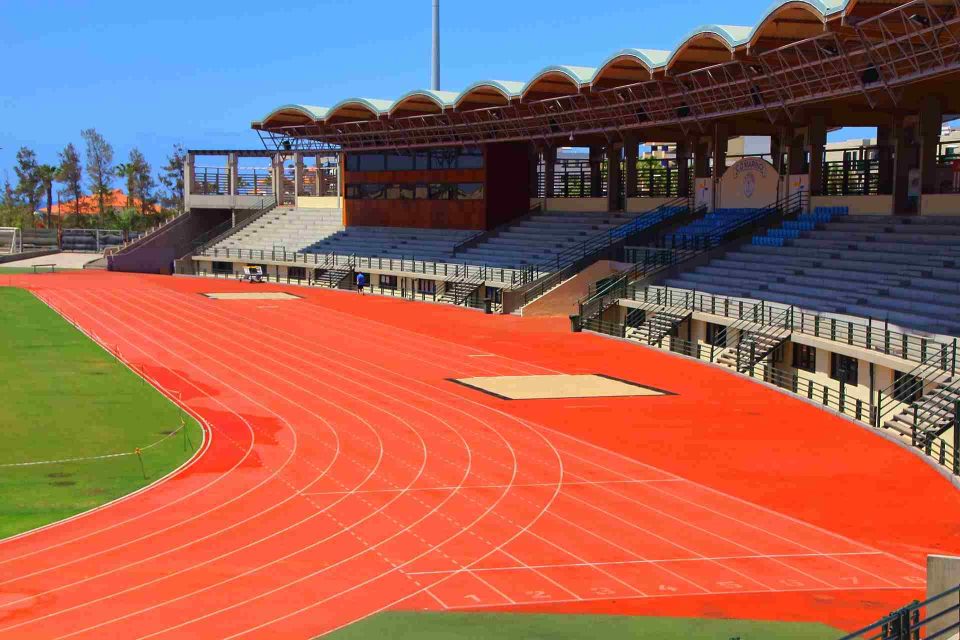Last Updated on June 4, 2024 by Admin
Sports facility construction is undergoing a major shift towards sustainability. Innovations like eco-friendly materials and energy-efficient systems are taking center stage, driven by growing environmental awareness. Developers now prioritize greener methods without sacrificing quality or performance.
Let’s explore five innovative strategies that are redefining sports facility construction for a greener future.
1. Green Roof Systems
Green roof systems revolutionize sports facility construction by integrating vegetation into the structure’s design. These roofs provide insulation, reduce stormwater runoff, and enhance biodiversity. Developers use hardy plants to withstand weather extremes while minimizing maintenance needs.
By incorporating green roofs, facilities improve energy efficiency – cutting heating and cooling costs significantly. Plus, they create visually appealing spaces that can host events or serve as relaxation areas for visitors.
This practice isn’t just about aesthetics; it’s a tangible commitment to environmental sustainability that pays off in both ecological and economic terms.
2. Solar Panel Integration
Solar panel integration leads the charge in making sports facilities more sustainable. Modern stadiums and arenas harness solar energy, significantly cutting down on reliance on non-renewable power sources. This practice reduces carbon footprints while generating substantial cost savings over time.
Panels are strategically placed to maximize sunlight exposure without disrupting the facility’s design or function. Additionally, some venues install transparent solar panels that double as windows, merging aesthetics with practicality.
By adopting solar technology, sports facilities demonstrate a proactive approach to sustainability, paving the way for renewable energy adoption in large-scale constructions.
3. Sustainable Artificial Turf
Sustainable artificial turf redefines sports field installation, focusing on eco-friendly materials and innovative designs.
Modern turfs use recycled plastics and natural infill alternatives like cork or coconut husks, reducing environmental impact. These sustainable options offer durability comparable to traditional turfs but with lower maintenance costs and reduced water usage. They also incorporate advanced drainage systems that prevent waterlogging and support effective rainwater harvesting.
By choosing sustainable artificial turf, sports facilities significantly cut down on resource consumption while maintaining high-performance standards. This practice ensures a greener footprint for both construction processes and long-term field usage.
4. Advanced LED Lighting Systems
Advanced LED lighting systems revolutionize the energy efficiency of sports facilities. These cutting-edge lights consume far less power than traditional incandescent or halogen bulbs, slashing electricity bills and reducing carbon footprints.
Modern LEDs offer superior brightness and longevity, ensuring optimal visibility for both players and spectators. They also feature smart control options that allow precise adjustments based on natural light levels or event requirements.
Incorporating advanced LED systems into sports venues not only enhances illumination quality but also demonstrates a strong commitment to sustainability by minimizing environmental impact through significant energy savings.
5. Water Recycling Systems
Water recycling systems are a game-changer in sports facility construction. These systems capture and treat greywater from showers, sinks, and irrigation to be reused within the facility. This reduces reliance on municipal water supplies and minimizes waste.
By integrating water recycling technologies, stadiums can efficiently maintain their fields and landscapes without depleting freshwater resources. This is especially critical in regions facing water scarcity.
The implementation of these systems showcases a proactive approach to sustainability, conserving vital resources while ensuring that sports facilities operate smoothly with minimal environmental disruption.
Looking Ahead: The Future of Sustainable Sports Facilities
The future of sports facilities shines brightly with sustainable innovations at the forefront. As technology evolves, expect even more advanced solutions to emerge, enhancing both environmental and economic benefits.
From renewable energy sources to eco-friendly materials, these practices promise a greener planet while maintaining top-tier performance standards.
Stakeholders – architects, developers, and sports organizations – must continue embracing these changes to drive further progress. By doing so, they will ensure that future generations enjoy state-of-the-art venues without compromising our ecological footprint.
Related Posts:
- Innovative Water Treatment Solutions for Sustainable Construction Projects
- The Importance of Carbon Neutrality and Sustainability in Today’s World
- Intelligent and Integrated Energy Systems: Paving the Way for a Sustainable Future
- Seven ways to improve your business’ energy efficiency
- A Comprehensive Guide to Facility Management Services


